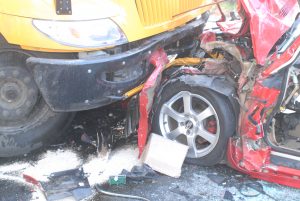After a car crash, it is not unusual to have at least two versions of how an “accident” happened from the humans involved in it. Some of this is a function of the locations of various witnesses when they made whatever observations that had of the events. So, for example, independent witnesses in traffic behind the point of collision may have sight lines obscured by traffic, weather and the configuration of the roadway. Even with great sight lines, a witness’ visual acuity may be less than perfect. Similarly, those in the involved vehicles may not have had the best view of the events leading up to a collision. Passengers may be sleeping, reading or otherwise distracted by events inside or outside the vehicle. In the case of larger commercial vehicles, like a bus, those in the back may not have a good view out the front. The involved operators, of course, while having what should be the best view of what happened outside their windshield, also have the greatest incentive to minimize their fault in causing a collision – even though they likely have insurance designed to cover any such unfortunate events. In short, human limitations and human bias, can often lead to difficulties in determining what really happened in a car or truck crash and who was at fault for the collision.
These issues can be exacerbated when responding police leap to factual conclusions by accepting the factual position of one party at the scene or inferences that can be drawn from the point of impact on the roadway. This is exactly what happened to one of our recent clients. He was involved in a head on collision with another car. The collision occurred in the other car’s lane. When the police arrived, based on their conversations with the operators, and their determination that the collision occurred in the woman’s lane of travel, they immediately began to focus on our client as the cause of the collision.
This changed, however, when our client was able to recover enough from the collision to point the police in the direction of his dash cam video. This shows that as the vehicles approached each other head on, the woman strayed into the oncoming lane as she was rounding a curve to her right. With about 3 seconds to respond, the other inexperienced driver instinctively tried to evade to the left. When the woman corrected back into her lane, the collision occurred causing our client’s car to spin off the road. The police determined the woman was at fault. Ultimately, we were able to recover fair monetary damages for our client.
 Boston Injury Attorney Blog
Boston Injury Attorney Blog


